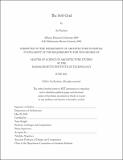The soft grid
Author(s)
Kardasis, Ari (Ari David)
DownloadFull printable version (2.471Mb)
Other Contributors
Massachusetts Institute of Technology. Dept. of Architecture.
Advisor
Terry Knight.
Terms of use
Metadata
Show full item recordAbstract
The grid in architecture is a systematic organization of space. The means that architects use to organize space are, almost by definition, rigid and totalizing. The Cartesian grid, which will serve as the antagonist of the soft grid, is geometrically and topologically unyielding on both the local and global scales. There are, however, alternatives to such hard grids. Through a series of studies, this thesis will catalog and analyze the soft girds, i.e. those that are adaptive, variable, scalable, asymmetrical and entropic. Computational tools in architecture have, in recent years, enabled designers to manage geometries that until now have been realizable only by analog means. The instrumental capacity for complex designs has lead to increased demand for soft gridding systems as is evidenced by the profusion of Voronoi diagrams, pixelations, distorted grids and Danzer tilings in student and conceptual work. However, the built scale of such projects is rarely beyond installation largely because of the difficulty in managing spatial organizations that are not essentially Cartesian. Th is thesis will lay the groundwork for a systematic understanding of the possibilities of soft grids while providing much of the computational tools to generate and manage specific examples.
Description
Thesis (S.M.)--Massachusetts Institute of Technology, Dept. of Architecture, 2011. This electronic version was submitted by the student author. The certified thesis is available in the Institute Archives and Special Collections. Cataloged from student submitted PDF version of thesis. Includes bibliographical references (p. 99-101).
Date issued
2011Department
Massachusetts Institute of Technology. Department of ArchitecturePublisher
Massachusetts Institute of Technology
Keywords
Architecture.